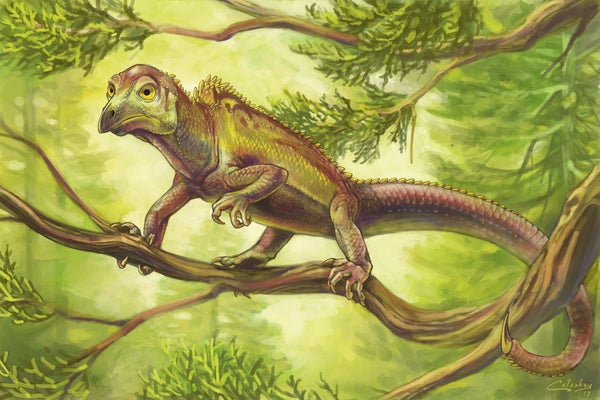This article was published in Scientific American’s former blog network and reflects the views of the author, not necessarily those of Scientific American
The Triassic doesn't get enough credit. Truly, it was one of the weirdest times for animal life on the planet. There were oddities galore, from strange little saurians with frond-like integument growing out of their backs to vacuum-mouthed marine reptiles unlike anything ever seen before. Yet not everything was anatomically insane. Within the gross disparity of the Triassic were glimmerings of themes evolution would return to over and over again.
Discoveries made over the past twenty years have underscored how the Triassic inadvertently established trends that would pop up again in the history of life. Effigia, for example, was a distant cousin of crocodiles that walked on two legs and superficially resembled the ostrich-mimic dinosaurs that would evolve tens of millions of years later. The little-known Triopticus, likewise, pioneered the dome-headed look later adopted by the pachycephalosaurs in the Cretaceous. And now there’s another animal that shows later Mesozoic creatures were copycats.
Paleontologists Adam Pritchard and Sterling Nesbitt described the creature in a new study. It was one of the drepanosaurs – enigmatic “monkey lizards” that had chameleon-like feet and claws on the tips of their tails. But the face of the animal would have looked more familiar. And as the title of their paper itself says, this drepanosaur from the famous Triassic Coelophysis Quarry of Ghost Ranch, New Mexico had a very “bird-like” face. Pieced back together from its initially smushed state, the cranial bones certainly have the wedge-shaped, light appearance of a bird’s skull. Little wonder that Pritchard and Nesbitt named the animal Avicranium renestoi (the species name honoring drepanosaur expert Silvio Renesto).
On supporting science journalism
If you're enjoying this article, consider supporting our award-winning journalism by subscribing. By purchasing a subscription you are helping to ensure the future of impactful stories about the discoveries and ideas shaping our world today.
The new skull helps add context to the history of these ancient weirdos. For example, Pritchard and Nesbitt point out, the new family tree generated by the study suggests that drepanosaurs had a much deeper origin than previously recognized and that they are non-saurian diapsids – that is, that belong to the broader family that includes dinosaurs and lizards, but are a more ancient lineage that was far removed from the more familiar forms.
And that’s not all. The bird-like features of the skull include eye sockets that are oriented forwards, presumably giving Avicranium binocular vision. This is consistent with the arboreal interpretation of this animal and its relatives, the ability to gauge distances being a handy ability when moving through a habitat as complex and tangled as the forest. This, Pritchard and Nesbitt write, “suggest[s] a complex sensory life for the animal and may explain the similarities in brain shape to flying and arboreal taxa.” Avicranium was no flier, but its skull was a rough precursor of what the first birds would evolve on their own over 50 million years later.
Reference:
Pritchard, A., Nesbitt, S. 2017. A bird-like skull in a Triassic diapsid reptile increases heterogeneity of the morphological and phylogenetic radiation of Diapsida. Royal Society Open Science. Doi: 10.1098/rsos.170499
